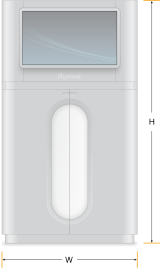Laboratory Requirements
Use the specifications and requirements provided in this section to set up the lab space.

|
Measurement |
Instrument Dimensions |
|---|---|
|
Height |
158.8 cm (62.5 in) |
|
Width |
86.4 cm (34 in) |
|
Depth |
93.3 cm (36.7 in) |
|
Weight |
588 kg (1296 lb)* |
* Total instrument weight after installation, including UPS and consumables.
Position the instrument to allow proper ventilation, access for servicing the instrument, and access to the power switch, power outlet, and power cord.
| • | Position the instrument so that personnel can reach around the right side of the instrument to turn on or turn off the power switch. This switch is on the back panel adjacent to the power cord. |
| • | Position the instrument so that personnel can quickly disconnect the power cord from the outlet. |
| • | Make sure that the instrument is accessible from all sides using the following minimum clearance dimensions. |
| • | Keep the front of the instrument clear of obstructions and floor clean to avoid clogging the air filter. |
| • | Place the UPS on either side of the instrument. The UPS can be placed within the minimum clearance range of the instrument sides. |
|
Access |
Minimum Clearance |
|---|---|
|
Front |
Allow at least 152.4 cm (60 in) in front of the instrument for opening the front doors and to provide general lab access for movement of personnel around the lab. |
|
Sides |
Allow at least 70 cm (27.5 in) on each side of the instrument for access and clearance around the instrument. Instruments placed side-by-side only require 70 cm (27.5 in) total between two instruments. |
|
Rear |
Allow at least 30.5 cm (12 in) behind the instrument placed next to a wall for ventilation and access. Allow at least 61 cm (24 in) between two instruments placed back-to-back. |
|
Top |
Make sure that shelving and other obstructions are not above the instrument. Allow at least 80 cm (31.5 in) above the instrument. |
Incorrect placement can reduce ventilation. Reduced ventilation increases heat output and noise output, which compromises data integrity and personnel safety.
Keep the vibration level of the lab floor at the VC-A standard of 50 μm/s for ⅓ octave band frequencies of 8–80 Hz, or lower. This level is typical for labs. Do not exceed the ISO Operating Room (baseline) standard of 100 μm/s for ⅓ octave band frequencies of 8–80 Hz.
During sequencing runs, use the following best practices to minimize vibrations and ensure optimal performance:
| • | Place the instrument on a flat hard floor and keep the clearance area free of clutter. |
| • | Do not place keyboards, used consumables, or other objects on top of the instrument. |
| • | Do not install the instrument near sources of vibration that exceed the ISO Operating Room standard. For example: |
| – | Motors, pumps, freezers, centrifuges, shake testers, drop testers, and heavy air flows in the lab. |
| – | Floors directly above or below HVAC fans, and controllers, and helipads. |
| – | Construction or repair work on the same floor as the instrument. |
| – | Areas with high foot traffic. |
| • | Keep sources of vibration such as dropped items and movement of heavy equipment at least 100 cm (39.4 in) from the instrument. |
| • | Use only the touch screen, keyboard, and trackpad to interact with the instrument. Do not directly impact the instrument surfaces during operation. |
